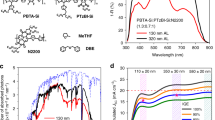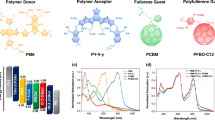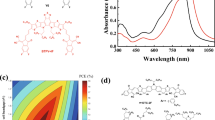Abstract
Tandem solar cells provide an effective way to harvest a broader spectrum of solar radiation by combining two or more solar cells with different absorption bands. However, for polymer solar cells, the performance of tandem devices lags behind single-layer solar cells mainly due to the lack of a suitable low-bandgap polymer. Here, we demonstrate highly efficient single and tandem polymer solar cells featuring a low-bandgap conjugated polymer (PBDTT-DPP: bandgap, ∼1.44 eV). A single-layer device based on the polymer provides a power conversion efficiency of ∼6%. When the polymer is applied to tandem solar cells, a power conversion efficiency of 8.62% is achieved, which is, to the best of our knowledge, the highest certified efficiency for a polymer solar cell to date.
This is a preview of subscription content, access via your institution
Access options
Subscribe to this journal
Receive 12 print issues and online access
$209.00 per year
only $17.42 per issue
Buy this article
- Purchase on Springer Link
- Instant access to full article PDF
Prices may be subject to local taxes which are calculated during checkout





Similar content being viewed by others
References
Würfel, W. Physics of Solar Cells (Wiley-VCH, 2005).
King, R. R. et al. 40% efficient metamorphic GaInP/GaInAs/Ge multijunction solar cells. Appl. Phys. Lett. 90, 183516 (2007).
Wang, X. H., et al. Tandem colloidal quantum dot solar cells employing a graded recombination layer. Nature Photon. 5, 480–484 (2011).
Riede, M. et al. Efficient organic tandem solar cells based on small molecules. Adv. Funct. Mater. 21, 3019–3028 (2011).
Xue, J., Uchida, S., Rand, B. P. & Forrest, S. R. Asymmetric tandem organic photovoltaic cells with hybrid planar-mixed molecular heterojunctions. Appl. Phys. Lett. 85, 5757–5759 (2004).
Kim, J. Y. et al. Efficient tandem polymer solar cells fabricated by all-solution processing. Science 317, 222–225 (2007).
Gilot, J., Wienk, M. M. & Janssen, R. A. J. Optimizing polymer tandem solar cells. Adv. Mater. 22, E67–E71 (2010).
Sista, S. et al. Highly efficient tandem polymer photovoltaic cells. Adv. Mater. 22, 380–383 (2010).
Chou, C. H. et al. Metal-oxide interconnection layer for polymer tandem solar cells with an inverted architecture. Adv. Mater. 23, 1282–1286 (2011).
Cheng, Y. J., Yang, S. H. & Hsu, C. S. Synthesis of conjugated polymers for organic solar cell applications. Chem. Rev. 109, 5868–5923 (2009).
Coakley, K. M. & McGehee, M. D. Conjugated polymer photovoltaic cells. Chem. Mater. 16, 4533–4542 (2004).
Brabec, J., Sariciftci, N. S. & Hummelen, J. C. Plastic solar cells. Adv. Funct. Mater. 11, 15–26 (2001).
Boudreault, P. T., Najari, A. & Leclerc, M. Processable low-bandgap polymers for photovoltaic applications. Chem. Mater. 23, 456–469 (2011).
Zhu, Z. et al. Panchromatic conjugated polymers containing alternating donor/acceptor units for photovoltaic applications. Macromolecules 40, 1981–1986 (2007).
Hou, J. et al. Synthesis, characterization, and photovoltaic properties of a low band gap polymer based on silole-containing polythiophenes and 2,1,3-benzothiadiazole. J. Am. Chem. Soc. 130, 16144–16145 (2008).
Liang, Y. Y., et al. Highly efficient solar cell polymers developed via fine-tuning of structural and electronic properties. J. Am. Chem. Soc. 131, 7792–7799 (2009).
Bijleveld, J. C. et al. Efficient solar cells based on an easily accessible diketopyrrolopyrrole polymer. Adv. Mater. 22, E242–E246 (2010).
Piliego, C. et al. Synthetic control of structural order in n-alkylthieno[3,4-c]pyrrole-4,6-dione-based polymers for efficient solar cells. J. Am. Chem. Soc. 132, 7595–7597 (2010).
Yu, G., Gao, J., Hummelen, J. C., Wudl, F. & Heeger, A. J. Polymer photovoltaic cells: enhanced efficiencies via a network of internal donor–acceptor heterojunctions. Science 270, 1789–1791 (1995).
Li, G., Chu, C.-W., Shrotriya, V., Huang, J. & Yang, Y. Efficient inverted polymer solar cells. Appl. Phys. Lett. 88, 253503 (2006).
White, M. S. et al. Inverted bulk-heterojunction organic photovoltaic device using a solution-derived ZnO underlayer. Appl. Phys. Lett. 89, 143517 (2006).
Liao, H-H. et al. Highly efficient inverted polymer solar cell by low temperature annealing of Cs2CO3 interlayer. Appl. Phys. Lett. 92, 173303 (2008).
Shrotriya, V. et al. Efficient light harvesting in multiple-device stacked structure for polymer solar cells. Appl. Phys. Lett. 88, 064104 (2006).
Padinger, F., Rittberger, R. S. & Sariciftci, N. S. Effects of postproduction treatment on plastic solar cells. Adv. Funct. Mater. 13, 85–88 (2003).
Li, G. et al. High-efficiency solution processable polymer photovoltaic cells by self-organization of polymer blends. Nat. Mater. 4, 864–868 (2005).
Peet, J. et al. Efficiency enhancement in low-bandgap polymer solar cells by processing with alkane dithiols. Nature Mater. 6, 497–500 (2007).
Chen, H. Y. et al. Polymer solar cells with enhanced open-circuit voltage and efficiency. Nature Photon. 3, 649–653 (2009).
Liang, Y. Y. et al. For the bright future—bulk heterojunction polymer solar cells with power conversion efficiency of 7.4%. Adv. Mater. 22, E135–E138 (2010).
Chu, T. Y. et al. Bulk heterojunction solar cells using thieno[3,4-c]pyrrole- 4,6-dione and dithieno[3,2-b:2′,3′-d]silole copolymer with a power conversion efficiency of 7.3%. J. Am. Chem. Soc. 133, 4250–4253 (2011).
Zhou, H. X. et al. Development of fluorinated benzothiadiazole as a structural unit for a polymer solar cell of 7% efficiency. Angew. Chem. Int. Ed. 50, 2995–2998 (2011).
He, Z. et al. Simultaneous enhancement of open-circuit voltage, short-circuit current density and fill factor in polymer solar cells. Adv. Mater. 23, 4636–4643 (2011).
Sista, S., Hong, Z. R., Chen, L. M. & Yang, Y. Tandem polymer photovoltaic cells—current status, challenges and future outlook. Energy Environ. Sci. 4, 1606–1620 (2011).
Yang, J. et al. A robust inter-connecting layer for achieving high performance tandem polymer solar cells. Adv. Mater. 23, 3465–3470 (2011).
Dennler, G. et al. Design rules for donors in bulk-heterojunction tandem solar cells—towards 15% energy-conversion efficiency. Adv. Mater. 20, 579–583 (2008).
Scharber, M. C. et al. Design rules for donors in bulk-heterojunction solar cells—towards 10% energy-conversion efficiency. Adv. Mater. 18, 789–794 (2006).
Huo, L. et al. Bandgap and molecular level control of the low-bandgap polymers based on 3,6-dithiophen-2-yl-2,5-dihydropyrrolo[3,4-c]pyrrole-1,4-dione toward highly efficient polymer solar cells. Macromolecules 42, 6564–6571 (2009).
Huo, L. J. et al. A polybenzo[1,2-b:4,5-b′]dithiophene derivative with deep HOMO level and its application in high-performance polymer solar cells. Angew. Chem. Int. Ed. 49, 1500–1503 (2010).
Shrotriya, V. et al. Accurate measurement and characterization of organic solar cells. Adv. Funct. Mater. 16, 2016–2023 (2006).
Bijleveld, J. C. et al. Poly(diketopyrrolopyrrole-terthiophene) for ambipolar logic and photovoltaics. J. Am. Chem. Soc. 131, 16616–16617 (2009).
Huo, L. J. et al. Replacement of alkoxy with alkylthienyl: a feasible approach to improve photovoltaic properties of PBDTTT-based polymers. Angew. Chem. Int. Ed. 50, 1–7 (2011).
Coffin, R. C., Peet, J., Rogers, J. & Bazan, G. C. Streamlined microwave-assisted preparation of narrow-bandgap conjugated polymers for high performance bulk heterojunction solar cells. Nature Chem. 1, 657–661 (2009).
He, Y. J., Chen, H.-Y., Hou, J. H. & Li, Y. F. Indene−C60 bisadduct: a new acceptor for high-performance polymer solar cells. J. Am. Chem. Soc. 132, 1377–1382 (2010).
Burdick, J. & Glatfelter, T. Spectral response and I–V measurements of tandem amorphous-silicon alloy solar cells. Solar Cells 18, 301–314 (1986).
Gilot, J., Wienk, M. M. & Janssen, R. A. J. Measuring the external quantum efficiency of two-terminal polymer tandem solar cells. Adv. Funct. Mater. 20, 3904–3911 (2010).
Sun, B. Q. & Sirringhaus, H. Solution-processed zinc oxide field-effect transistors based on self-assembly of colloidal nanorods. Nano Lett. 5, 2408–2413 (2005).
Beek, W. J. E., Wienk, M. M. & Janssen, R. A. J. Efficient hybrid solar cells from zinc oxide nanoparticles and a conjugated polymer. Adv. Mater. 16, 1009–1013 (2004).
Meusel, M. et al. Spectral response measurements of monolithic GaInP/Ga(In)As/Ge triple-junction solar cells: measurement artifacts and their explanation. Prog. Photovolt. Res. Appl. 11, 499–514 (2003).
Acknowledgements
This work was financially supported by the National Science Foundation (NSF, grant no. CHE0822573; programme manager: C. Foss), the Air Force Office of Scientific Research (AFOSR, grant no. FA9550-09-1-0610; programme manager: C. Lee) and the Office of Naval Research (ONR, grant no. N00014-04-1-0434; programme manager: P. Armistead), as well as by the US Department of Energy (contract no. DE-AC36-08-GO28308) together with the National Renewable Energy Laboratory. The authors thank R. Green, E. Richard, W.B. Yang and W.-C. Hsu of the Department of Materials Science and Engineering at UCLA for material testing, synthesis, ultraviolet photoelectron spectroscopy and X-ray diffraction measurements, respectively. Thanks also go to K.N. Houk and B. Martin of the Department of Chemistry (UCLA) for the quantum chemical calculation and R. Kaner and P. Weiss of the Department of Chemistry (UCLA) for reading the manuscript.
Author information
Authors and Affiliations
Contributions
L.D. and J.You contributed equally to this work. L.D., J.You and Y.Y. developed the ideas. L.D. designed the chemical structure and performed materials synthesis and characterization. J.You fabricated the inverted tandem device and carried out data analysis. Y.H. and J.Yang participated in material synthesis and characterization. S.M. provided the ZnO for ICL. C.C. modified the PEDOT for ICL. T.M. and K.E. performed the certification at NREL. G.L. guided device testing at UCLA and coordinated certification. L.D., J.You, G.L. and Y.Y. prepared the manuscript. All authors discussed the results and commented on the manuscript. Y.Y. planned and supervised the project.
Corresponding author
Ethics declarations
Competing interests
The authors declare no competing financial interests.
Supplementary information
Supplementary information
Supplementary information (PDF 567 kb)
Rights and permissions
About this article
Cite this article
Dou, L., You, J., Yang, J. et al. Tandem polymer solar cells featuring a spectrally matched low-bandgap polymer. Nature Photon 6, 180–185 (2012). https://doi.org/10.1038/nphoton.2011.356
Received:
Accepted:
Published:
Issue Date:
DOI: https://doi.org/10.1038/nphoton.2011.356
This article is cited by
-
(Z)-4-(thiophen-2-ylmethylene)-4H-thieno[2,3-b]pyrrol-5(6H)-one based polymers for organic photovoltaics
Journal of Polymer Research (2023)
-
Tandem organic solar cells with efficiency over 19% via the careful subcell design and optimization
Science China Chemistry (2023)
-
Recent progress in organic solar cells (Part II device engineering)
Science China Chemistry (2022)
-
Preparation of hydrogen, fluorine and chlorine doped and co-doped titanium dioxide photocatalysts: a theoretical and experimental approach
Scientific Reports (2021)
-
Computational studies of diindole-based molecules for organic bulk heterojunction solar devices using DFT and TD-DFT calculations
Structural Chemistry (2021)



